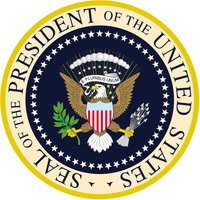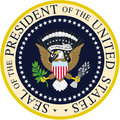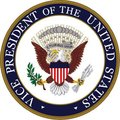Andrew Jackson
|
|
| ||
| Order: | 7th President | |
| Vice President: | John C. Calhoun (1829-1832) Martin Van Buren (1833-1837) | |
| Term of office: | March 4, 1829 – March 3, 1837 | |
| Preceded by: | John Quincy Adams | |
| Succeeded by: | Martin Van Buren | |
| Date of birth: | March 15, 1767 | |
| Place of birth: | Waxhaws area of North Carolina | |
| Date of death: | June 8, 1845 | |
| Place of death: | The Hermitage, Nashville, Tennessee | |
| First Lady: | Rachel Donelson Robards Jackson | |
| Political party: | Democrat | |
Andrew Jackson (March 15, 1767 – June 8, 1845) was the seventh President of the United States, serving from 1829 to 1837. Until his election, every President had either been a member of the Virginia plantation elite, or had been named Adams. Jackson, nicknamed "Old Hickory," was neither of those. He was the first president who had lived on the American frontier, and thus the first not primarily associated with one of the original thirteen colonies. Jackson became the symbol of an era in American history — sometimes called the "Age of Jackson" or the "Jacksonian Era" — an era traditionally seen as dominating the years between the War of 1812 and the Civil War.
| Contents |
Early life
Born in a backwoods settlement in the Waxhaws area in the Carolinas on March 15, 1767, he received a sporadic education. At age thirteen he joined the Continental Army as a courier. He was captured and imprisoned by the British in the American Revolutionary War. When he refused to clean the boots of a British officer, the irate redcoat slashed him with a sword, giving Jackson the scars (and intense hatred for the British) that he would carry all his life. This anglophobia would be combined with a distrust and dislike of Eastern aristocrats stemming from his feeling that they were too inclined to favor and emulate their former colonial masters. Jackson admired Napoleon Bonaparte for his willingness to contest British military supremacy.
The war also took the lives of Jackson's entire immediate family. He came to Tennessee shortly after 1800, as a young lawyer. Since he was not of a distinguished family, he had to make his career by his own merits, and soon he began to prosper in the rough-and-tumble world of frontier law. He became a colonel in the state militia, which began his military career.
His service in the War of 1812 was conspicuous for its bravery and success. He was popular with his troops and was said to have been "tough as old hickory" wood on the battlefield, which gave him his nickname. The war, and particularly his command at the Battle of New Orleans on January 8, 1815, made his national reputation and he advanced in rank to Major General.
His subsequent political rise was rapid. He was elected to both houses of Congress and served on the state supreme court. He saw military service again in 1818 and campaigned in Florida against Spain, helping secure that territory for the United States. He subsequently was appointed territorial governor there.
Jackson's influence
During his first run for the Presidency in 1824, Jackson received a plurality of both the popular and electoral votes, but not a majority. The election was thrown into the House of Representatives, which chose John Quincy Adams instead. The election was considered dirty and, by many, stolen. Jackson himself favored reform of the electoral system afterwards, including abolishing the U.S. Electoral College. Jackson's defeat burnished his political credentials, however, since many voters believed the man of the people had been robbed by the corrupt aristocrats of the East. He won a solid victory in his second attempt in 1828 as the first nominee of the Democratic Party.
Jackson was the first U.S. President to come from outside the original Revolutionary circle. Washington, Adams, Jefferson and Madison were notable figures in the War of Independence and in the formation of the U.S. Constitution. James Monroe fought in the Revolutionary War. John Quincy Adams was the son of John Adams. Jackson's election represented a significant break from that past.
He was also the first President from a state west of the Appalachian Mountains. (Though born in the Carolinas, Jackson spent virtually all his adult life in Tennessee.) This was the first election in which many states allowed people without land to vote, and they voted for Jackson.
Jackson is remembered for introducing the spoils system, or patronage, to American politics. Upon his election as President, a sizable number of people holding federal offices found that they had suddenly been replaced by supporters of Jackson who had worked to ensure his election. Jackson saw this system as promoting the growth of democracy, as more people were involved in politics. This practice has endured in political circles in the United States ever since. Additionally, Jackson pressured states to lower voting requirements to further the expansion of democracy.
Jackson's opposition to the National Bank
As President, Jackson worked to dismantle the Second Bank of the United States. The original Bank of the United States had been introduced in 1791 by Alexander Hamilton as a way of organizing the federal government's finances. This first Bank lapsed in 1811. It was followed by the second Bank, authorized by James Madison in 1816 to alleviate the economic problems caused by the War of 1812. Both Banks were instrumental in the growth of the U.S. economy, but Jackson opposed the concept on ideological grounds. In Jackson's opinion, the Bank needed to be abolished because:
- it was unconstitutional;
- it concentrated an excessive amount of the nation's financial strength;
- it exposed the government to control by foreign interests;
- it exercised too much control over members of U.S. Congress;
- it favored Northeastern states over Southern and Western (now Midwestern) states.
Jackson's opposition to the Bank manifested as a strong personal dislike for its president, Nicholas Biddle.
Jackson followed Jefferson as a supporter of the ideal of an agricultural republic, and felt the Bank improved the fortunes of an elite circle of commercial and industrial entrepreneurs at the expense of farmers and laborers. After a titanic struggle, Jackson succeeded in destroying the Bank by vetoing its 1832 recharter by Congress and withdrawing U.S. funds in 1833. It was a Pyrrhic victory, however, as the Bank's money-lending functions were taken over by the legions of local and state banks that sprang up along with the expansion of credits and speculation, and the commercial progress of the nation's economy was not noticeably dented. The United States Senate censured Jackson on March 27, 1834 for his actions in defunding the Bank of the United States.
Nullification crisis
Another notable crisis of Jackson's period of office was the nullification crisis (or secession crisis), of 1828-1832, which merged issues of sectional strife and disagreements over trade tariffs. High tariffs (the "Tariff of Abominations") on imports of common goods were seen by many in Southern states as unfairly benefiting Northern merchants and industrial entrepreneurs at the expense of those who had to buy the goods subject to the tariffs, mostly Southern farmers. The issue came to a head when Vice President John C. Calhoun, in the South Carolina Exposition and Protest of 1832, supported the claim of his home state, South Carolina, that it had the right to "nullify" — declare illegal — the tariff legislation of 1828, and more generally the right of a state to nullify laws which went against its interests. Although Jackson sympathized with the Southern interpretation of the tariff debate, he was also a strong supporter of federalism (in the sense of supporting a strong union with considerable powers for the central government) and attempted to face Calhoun down over the issue, which developed into a bitter rivalry between the two men. Particularly famous was an incident at the April 13, 1829 Jefferson Day dinner, involving after-dinner toasts. Jackson rose first and voice booming, yelled out "Our federal Union: IT MUST BE PRESERVED!", a clear challenge to Calhoun. Calhoun responded in a trembling voice "The Union: next to our liberty, most dear!," an astonishingly quick-witted riposte.
The crisis was resolved in 1833 with a compromise settlement which, by substantially lowering the tariffs, hinted that the central government considered itself weak in dealing with determined opposition by an individual state.
Indian Removal
Jackson was a strong supporter of the policy of Indian Removal, and he signed the Indian Removal Act into law in 1830. The Removal Act did not order the removal of any American Indians, but it authorized the President to negotiate treaties that would exchange tribal land in the east for western lands that had been acquired in the Louisiana Purchase. According to biographer Robert V. Remini, Jackson favored relocating Native American tribes outside existing states primarily for national security reasons, since most American Indians had sided with the British in the Revolution and the War of 1812.
The Removal Act was especially popular in the South, where population growth and the discovery of gold on Cherokee land increased pressure on tribal lands. The state of Georgia became involved in a contentious jurisdictional dispute with the Cherokees, culminating in the 1832 Supreme Court decision (Worcester v. Georgia) that ruled that Georgia could not impose its laws upon Cherokee tribal lands.
However, Jackson had no intention of protecting the Cherokees from the state of Georgia, although the famously defiant quote attributed to him ("John Marshall has made his decision, now let him enforce it!") was probably never uttered by Jackson. Realizing that removal under Jackson was inevitable, a faction of Cherokees led by Major Ridge negotiated the Treaty of New Echota with Jackson's administration, a document of dubious legality that was rejected by most Cherokees. However, the terms of the treaty were strictly enforced by Jackson's successor, Martin van Buren, which resulted in the deaths of thousands of Cherokees along the "Trail of Tears".
Assassination attempt
JacksonAssassinationAttempt.jpg
On January 30, 1835 an unsuccessful assassination attempt against Jackson occurred in the United States Capitol. This was the first assassination attempt against an American President. While Jackson was leaving a funeral for South Carolina congressman Warren R. Davis, a mentally ill man named Richard Lawrence, an unemployed house painter, came up to him and fired a pistol at point-blank range. The pistol misfired, and before anyone could react, the assassin pulled another pistol and amazingly, that pistol also misfired. Instead of running or taking cover, the 67-year-old president proceeded to chase Lawrence and beat him over the head with his cane. The print (shown left) made 20 years later became quite popular because it shows the president boldly confronting his attacker.
Jackson's family
Jackson's wife, Rachel, died of a heart attack just 2 months prior to his taking office as President. She had supposedly divorced her first husband, Col. Lewis Robards, but there were questions about the legality of the divorce, and she was never accepted in polite society. Jackson deeply resented attacks on his wife's honor; he killed Charles Dickinson in a duel over an insult to his wife on May 30, 1806. Jackson was also injured during the duel and the bullet was so close to his heart that it could never be safely removed. It caused him considerable pain for the rest of his life. His only child was an adopted son, Andrew, Jr. In his will, Jackson left his granddaughter several slaves, his two grandsons each one male slave, and his daughter-in-law four female slaves, one of whom he had bought for her and the other three of whom were household servants.
Later life
Andrew_Jackson_Portrait.jpg
Jackson remained influential in both national and state politics after retiring to The Hermitage, his Nashville home in 1837. Though a slaveholder, Jackson was a firm advocate of the federal union of the states and declined to give any support to talk of secession. He died at the Hermitage in 1845, of chronic tuberculosis, and heart failure. Fittingly enough, his pet parrot Poll was removed from his funeral for screaming curse words at the mourners!
Due to his support for state rights, he was later considered as a philosophical forerunner of the Confederacy and was pictured on the Confederate $1000 bill.
Movie and biography
The story of Andrew and Rachel Jackson's life together was told in Irving Stone's best-selling 1951 biographical novel The President's Lady, which was made into the 1953 movie of the same title, starring Susan Hayward, Charlton Heston, John McIntire, and Carl Betz and directed by Henry Levin. The relationship between the two was also the basis of a successful documentary by the Public Broadcasting System, called Rachel and Andrew Jackson: A Love Story.
Supreme Court cases during his presidency
Major presidential acts
- Maysville Road Veto
- Signed Indian Removal Act of 1830
- Vetoed renewal of Second Bank of the United States (1832)
- Signed Force Bill of 1833
- Executive Order: Specie Circular (1836)
Quotes
- "Corporations have neither bodies to kick nor souls to damn."
- "One man with courage makes a majority."
- "To the victor goes the spoils."
- "It is a damn poor mind indeed which can think of only one way to spell a word."
- "There are no necessary evils in government. Its evils exist only in its abuses."
- "There is no pleasure in having nothing to do; the fun is having lots to do and not doing it."
- "Any man worth his salt will stick up for what he believes right, but it takes a slightly better man to acknowledge instantly and without reservation that he is in error."
- "I know what I am fit for. I can command a body of men in a rough way, but I am not fit to be president."
- "Our federal union. It must be preserved!"
Presidency
Cabinet
| OFFICE | NAME | TERM |
| President | Andrew Jackson | 1829–1837 |
| Vice President | John C. Calhoun | 1829–1832 |
| Martin Van Buren | 1833–1837 | |
| Secretary of State | Martin Van Buren | 1829–1831 |
| Edward Livingston | 1831–1833 | |
| Louis McLane | 1833–1834 | |
| John Forsyth | 1834–1837 | |
| Secretary of the Treasury | Samuel Ingham | 1829–1831 |
| Louis McLane | 1831–1833 | |
| William Duane | 1833 | |
| Roger B. Taney | 1833–1834 | |
| Levi Woodbury | 1834–1837 | |
| Secretary of War | John H. Eaton | 1829–1831 |
| Lewis Cass | 1831–1836 | |
| Attorney General | John M. Berrien | 1829–1831 |
| Roger B. Taney | 1831–1833 | |
| Benjamin F. Butler | 1833–1837 | |
| Postmaster General | William Barry | 1829–1835 |
| Amos Kendall | 1835–1837 | |
| Secretary of the Navy | John Branch | 1829–1831 |
| Levi Woodbury | 1831–1834 | |
| Mahlon Dickerson | 1834–1837 | |
Supreme Court appointments
States admitted to the Union
References
- Brustein, Andrew. The Passions of Andrew Jackson. New York: Knopf, 2003. ISBN 0375414282
- James, Marquis. The Life of Andrew Jackson New York: Bobbs-Merrill, 1938. Combines two books: The Border Captain and Andrew Jackson: Portrait of a President; winner of the Pulitzer Prize for Biography.
- Remini, Robert V. The Life of Andrew Jackson. Abridgment of Remini's 3-volume biography, originally published New York: Harper, 1998 (ISBN 0060159049); reprinted 2001 (ISBN 0060937351).
- Remini, Robert V. Andrew Jackson and his Indian Wars. New York: Viking, 2001. ISBN 0670910252.
- Schlesinger, Arthur M. Jr. The Age of Jackson. Originally published Boston: Little, Brown, 1945, often reprinted. ISBN 0316773441. Winner of the Pulitzer Prize for History.
- Wallace, Anthony F.C. The Long, Bitter Trail: Andrew Jackson and the Indians. New York: Hill & Wang, 1993. ISBN 0809015528 (paperback), ISBN 0809066319 (hardback).
See also
- United States dollar — Jackson's portrait appears on the $20 bill. He has appeared on $5, $10, $50, and $10,000 bills in the past, as well as a Confederate $1,000.
- Blackjack United States postage stamp
- U.S. presidential election, 1824
- U.S. presidential election, 1828
- U.S. presidential election, 1832
- List of places named for Andrew Jackson
- The Hermitage, Andrew Jackson's home, now a tourist destination
History Clipart and Pictures
- Pictures of the US Presidents (http://classroomclipart.com/cgi-bin/kids/imageFolio.cgi?direct=History/United_States/Presidents)
- Clipart of American Presidents (http://classroomclipart.com/cgi-bin/kids/imageFolio.cgi?direct=Clipart/American_Presidents)
- Historical Pictures of the United States (http://classroomclipart.com/cgi-bin/kids/imageFolio.cgi?direct=History/United_States)
- Pictures of the American Revolution (http://classroomclipart.com/cgi-bin/kids/imageFolio.cgi?direct=History/United_States/American_Revolution)
- Civil Rights Pictures (http://classroomclipart.com/cgi-bin/kids/imageFolio.cgi?direct=History/United_States/Civil_Rights)
- Civil War Images (http://classroomclipart.com/cgi-bin/kids/imageFolio.cgi?direct=History/United_States/Civil_War)
- Pictures of Colonial America (http://classroomclipart.com/cgi-bin/kids/imageFolio.cgi?direct=History/United_States/Colonial_America)
- Historical US Illustrations (http://classroomclipart.com/cgi-bin/kids/imageFolio.cgi?direct=History/United_States/Illustrations)
- World War II Pictures (http://classroomclipart.com/cgi-bin/kids/imageFolio.cgi?direct=History/United_States/World_War_II)
- Pictures of Historical People (http://classroomclipart.com/cgi-bin/kids/imageFolio.cgi?direct=History/United_States/People)
External links
- Andrew Jackson on the Web (resource directory) (http://www.isidore-of-seville.com/jackson/)
- Critical Resources: Andrew Jackson and Indian Removal (http://www.synaptic.bc.ca/ejournal/jackson.htm)
- A genealogical profile of the President (http://www.bargeron.com/genealogy/gsb/f3802.html)
- Jackson's medical history (http://www.doctorzebra.com/prez/g07.htm)
- Portraits of Jackson on bank notes (http://www.currencygallery.org/vignettes/jackson.htm)
- PBS documentary on Rachel & Andrew's life together (http://www.wnpt.net/rachel/rachel_andrew/together.html)
Inaugural addresses
- First Inaugural Address (http://www.yale.edu/lawweb/avalon/presiden/inaug/jackson1.htm)
- Second Inaugural Address (http://www.yale.edu/lawweb/avalon/presiden/inaug/jackson2.htm)
State of the Union addresses
- First State of the Union of Andrew Jackson (http://www.usa-presidents.info/union/jackson-1.html)
- Second State of the Union of Andrew Jackson (http://www.usa-presidents.info/union/jackson-2.html)
- Third State of the Union of Andrew Jackson (http://www.usa-presidents.info/union/jackson-3.html)
- Fourth State of the Union of Andrew Jackson (http://www.usa-presidents.info/union/jackson-4.html)
- Fifth State of the Union of Andrew Jackson (http://www.usa-presidents.info/union/jackson-5.html)
- Sixth State of the Union of Andrew Jackson (http://www.usa-presidents.info/union/jackson-6.html)
- Seventh State of the Union of Andrew Jackson (http://www.usa-presidents.info/union/jackson-7.html)
- Final State of the Union of Andrew Jackson (http://www.usa-presidents.info/union/jackson-8.html)




